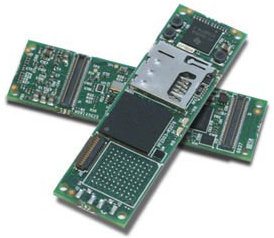Entry-level Overo module is just $99 in quantity
Sep 20, 2011 — by Eric Brown — from the LinuxDevices Archive — 5 viewsGumstix announced a entry-level version of its Linux-ready Overo computer-on-module (COM) that sells for as little as $99 in quantity. The “Sand” includes a 600MHz Texas Instruments OMAP3503 processor, 256MB of RAM, and the same 2.3 x 0.2 inch format as the other Overos, but drops onboard flash storage.
According to Gumstix, the new Overo Sand — with 256MB of RAM and no onboard flash memory — is a "perfect entry point for simple product designs and production needs." It is still fully capable of running operating systems such as Ubuntu Linux or Windows CE 6.0, but a bootable image must be installed into the device's microSD expansion slot, the company says.
Meanwhile, Gumstix says it has doubled the memory and flash storage for its existing Overo Air, Earth, FE, Tide, and Water modules (detailed further later in this story). All these devices, still priced from approximately $150 to $229 in single quantities, now come with 512MB of RAM and 512MB of flash, the company says.

Overo Sand
Like its many siblings, the entry-level Sand (above) is, yet again, a 2.3 x .7 x 0.2 inch module that includes dual expansion connectors with a total of 140 pins. Signals relayed include I2C, six PWM lines, six A/D connections, a UART, SPI, audio (headset/microphone), plus both USB host and On-The-Go ports, according to Gumstix.
The Sand also has the 27-pin camera connector common to the other Overo modules, and utilized by options such as E-Con's e-CAM50 OMAP Gstix (a five megapixel autofocus device). A wealth of other compatible add-ons includes Gumstix' recently introduced RoboVero board, designed to incorporate the Overo modules into robots.
The Wi-Fi and Bluetooth functionality resident on some other Overo modules is not a standard feature of the Sand. Also, the module employs TI's 600MHz OMAP3503, which, while it's Cortex A8-based, doesn't offer the OpenGL ES 2.0 compatibility or digital signal processor found on the OMAP3530.
Overo background
The Overo was launched by Gumstix in 2008 as a more powerful follow-on to its Verdex modules. All the Overo modules incorporate either the low-end (OMAP3503) or high-end (OMAP3530) versions of TI's Cortex-A8-based OMAP35x SoCs.
The Overo Earth and Overo Air (which adds Wi-Fi) both run on a 600MHz OMAP3503. The Overo Water (which adds OpenGL graphics), and Overo Fire (with OpenGL and Wi-Fi) originally ran on a 600MHz OMAP3530, but now use the faster 720MHz version of the SoC.
The high-end Overo FE, meanwhile, sticks with the 600MHz clock speed, but provides extended-temperature components as well as onboard Bluetooth and Wi-Fi. Last December, the company added an Overo Tide module, which was the first to double RAM to 512MB but, like the new Sand, has no flash storage.
All the Overo modules are supported by Gumstix with a variety of expansion boards and Linux-ready development kits. Options include a touchscreen LCD, HDMI-over-DVI, accelerometer, USB high speed and OTG, 10/100 Ethernet (including dual Ethernet port support), NiMH battery power, and much more.
Availability
The Overo Sand is available now for $115 in single quantities, or "less than $99 per COM in a 1,000 unit order." More information on the Sand and the other Overo modules may be found on the Gumstix Overo product page.
This article was originally published on LinuxDevices.com and has been donated to the open source community by QuinStreet Inc. Please visit LinuxToday.com for up-to-date news and articles about Linux and open source.